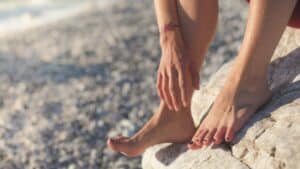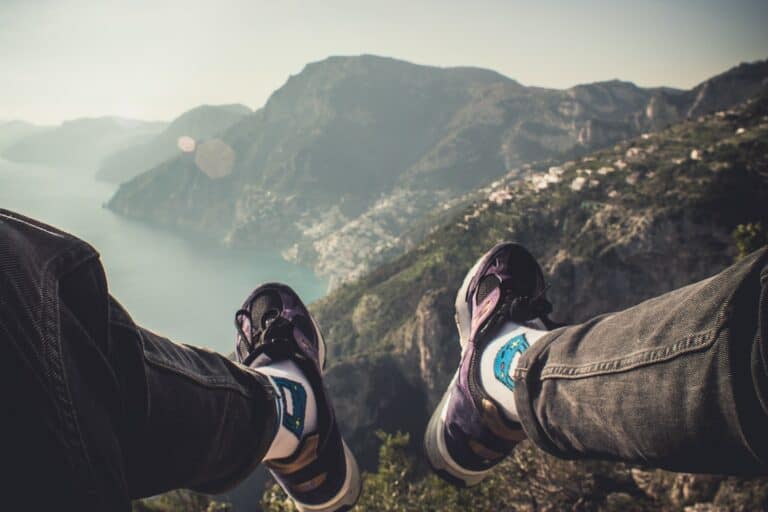Ever wondered why your feet hurt so much after a long day’s hike? I’ve been there and I’ve got some tips for feet when hiking that’ll make your next trip a breeze. In this article, we’ll explore some crucial foot care strategies you need to know before hitting the trails.
Choosing the Right Footwear

Picking the right footwear is the key to a comfortable hike. Today, there are endless options in the market for hiking boots and shoes. Don’t be swayed by trending designs or brand names. Always prioritize comfort and fit.
It’s advisable to try a few different styles and brands to find that perfect fit. Remember, a well-fitting shoe is one that holds your feet firmly without causing pressure points. Also, note that the right time to try new shoes is later in the day when feet naturally tend to be at their largest.
Now coming to boots vs shoes, both have their pros and cons. Boots offer more ankle support and are great for heavy backpacking and rough trails. They also provide better water and snow protection. Shoes, on the other hand, are lightweight and great for day hikes.
In choosing between the two, consider the terrain you’ll be hiking and the weight of your backpack. If you’re hiking on gentle trails and have a light pack, shoes may suffice. If, however, you’re up for more challenging trails or carrying a heavy pack, then boots might be the better choice for you.
Also, think about the kind of traction you’ll need. Hiking footwear usually has sturdier and more aggressive treads compared to regular shoes. Look for soles that will give you good grip on both wet and dry surfaces.
While we’re on the topic of soles, let’s also talk about insoles. Many hikers swear by custom or semi-custom orthotics. These can add arch support, cushioning, and extra comfort. They are especially recommended for those with specific foot conditions.
Breaking in Your Hiking Shoes
After discussing the importance of selecting the right footwear, let’s now talk about the process of breaking in a new pair. Many beginners and even experienced hikers overlook this, but breaking in your hiking shoes or boots is crucial for a comfortable journey.
If you’ve chosen your hiking footwear with care—prioritizing comfort, fit, traction, and orthotic support—you’re off to a great start. However, there’s more to be done. Fresh out of the box, even the most ideal pair of hiking shoes or boots will need time to mold to your feet. You don’t want to find yourself halfway through your hike when hotspots start to form, leading to blister formation.
Breaking in new hiking footwear is not a complicated process, but it does require some time and patience. Start by wearing your new hiking shoes or boots around the house. This will allow the footwear to take the shape of your feet without placing too much stress on them. Gradually begin wearing them during short walks in your neighborhood.
Watch for any signs of discomfort, such as tight spots or rubbing areas. If you identify any, you can use a shoe stretcher or take the footwear to a professional. While most hiking footwear will adjust to your feet over time, don’t risk your comfort and safety on the trail if initial wear isn’t promising.
You’ll likely experience some degree of discomfort as you break in your hiking shoes or boots. However, remember that small annoyances can become significant hurdles in the middle of a hike. Having your footwear perfectly molded to your feet can make all the difference in your hiking experience.
Socks Matter Too

Don’t let the simplicity of socks fool you! Although footgear like boots and shoes receive great importance – with good reason – the humble sock plays a crucial part in maintaining your feet’s comfort during those long, and often challenging, hiking trips as well.
Choosing the right grade and fabric for your hiking socks can truly make a huge difference in your outdoor pursuits. When it comes to fabric, you can’t go wrong with merino wool. This super-soft, itch-free wool is a marvel to the hiking world with its unique ability to help regulate temperature. Whether you’re tackling snow-capped peaks or arid desert trails, these socks can keep your feet comfortable in a wide range of climates. Plus, its proven moisture-wicking and odor-resistant properties add another layer of goodness to your hiking experience.
You might be asking if you should layer your socks. Definitely! For best results, try a two-sock system. The inner layer, preferably thin synthetic liner socks, wick away sweat from the skin and reduce friction. This directly helps minimize blisters. The outer layer, featuring the aforementioned merino wool, provides cushioning and further aids moisture management.
When it comes to the question of sock thickness, there’s no hard and fast rule. It entirely depends on the fit of your footwear, your personal preference, and the expected weather conditions. Thicker socks provide more insulation but are potentially hotter, while thinner socks may lack comfort and durability.
Finally, as I usually recommend, don’t forget to try before you buy. Similar to hiking footwear, the sock that’s perfect for me might not be for you – so try on different options and sizes until you find the pair that feels ‘just right’. Remember, comfort is king!
And there you have it – an often overlooked yet vital piece of your hiking armor. Knowledge about your feet’s ‘second skin’ can make those miles of scenic landscapes even more enjoyable.
Taking Care of Your Feet on the Trail
While adequate prep work goes a long way, real foot care starts on the trail. I’ve often said it’s better to prevent than treat, and in the realm of feet that’s certainly true. So, what does trail foot care look like?
To start with, it’s essential to check your feet periodically during your hike—don’t wait for feet to start hurting. If you notice a hot spot, act right away. Hot spots are early warnings of a blister. If ignored, they’ll become painful blisters that will slow down your hike or worse. Act on them promptly by applying blister tape or a similar dressing.
Making adjustments to your footwear on the fly can also make or break a hike. Maybe your hiking boots or shoes need loosening, or your socks need to be adjusted. Listen to what your feet are telling you. They’re your most valuable asset on the trail.
Let’s not forget about the simple but effective method of changing socks. Fresh socks do wonders for weary feet. If you’ve got an especially long or strenuous hike ahead, pack a few extra pairs. Switching out wet socks for dry ones can prevent fungus infections and blisters. Moreover, fresh socks provide a moral boost that’s almost as good as a cool stream on a hot day.
And, speaking of water, allowing your feet to breathe also comes in handy. Whenever you’re taking a break, pop off those boots and socks and give your feet some air. If a stream is nearby, dip your feet in. The cool water helps reduce inflammation and feels fantastic after a long trek.
Remember, if you take care of your feet, they’ll take care of you, making every hike a comfortable and enjoyable journey. That’s the mark of a seasoned hiker.
Treating Blisters and Hotspots

If you’re an avid hiker like me, you’ll no doubt be familiar with the perils of blisters and hotspots. These pesky little nuisances can turn a stunning outdoor adventure into a painful ordeal real fast. I believe it’s essential to know how to treat these common hiking complaints promptly and effectively.
Hotspots usually serve as a precursor to a blister. It’s the first sign of rubbing or friction in your boots. You’ll feel a slightly painful, warm area on your foot – hence the name ‘hotspot’. These are easier to manage than blisters because they don’t involve broken skin. Here’s my go-to advice on dealing with hotspots:
- Stop hiking at the first sign of discomfort. Ignoring a hotspot can quickly lead to a painful blister.
- Look for the problem. It could involve a seam, a bit of grit or badly fitting footwear.
- Once you find the cause, apply a piece of moleskin or athletic tape to the hotspot area that ‘floats’ over the hotspot.
When dealing with blisters, the process is a bit more complex. If you’ve got a blister on your hike, don’t panic, it’s manageable. First, clean the blister and the skin around it using warm water and mild soap. Avoid popping the blister as it could lead to infection. Apply an antibiotic ointment and cover the blister with a bandage.
If the blister is large and painful, you might need to drain it. Clean a needle with alcohol, puncture the edge of the blister, and gently squeeze out the fluid. Apply ointment and cover it with a bandage or duct tape.
Just remember, prevention is always better than cure. Keep your feet dry, wear the right socks and boots, and make sure everything fits well. Your feet will thank you later.
Conclusion: Tips for Feet When Hiking
So there you have it. We’ve navigated the terrain of foot care while hiking, tackling hotspots and blisters head-on. We’ve learned that it’s crucial to stop and address discomfort the moment it starts. Using moleskin or athletic tape can make a world of difference.
We’ve also delved into the world of blisters, understanding the importance of cleaning and caring for them properly. Remember, popping isn’t always the best solution. Sometimes, a clean needle, some antibiotic ointment, and a bandage can do the trick.
But most importantly, we’ve discovered that prevention is key. Keeping your feet dry, wearing the right gear, and ensuring a perfect fit are all part of the equation. Because when it comes to hiking, it’s all about stepping forward with confidence. And with these tips, you’ll be well on your way to doing just that. Happy hiking!


